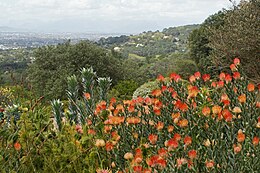| UNESCO World Heritage Site | |
|---|---|
 | |
| Location | South Africa |
| Includes | |
| Criteria | Natural: (ix), (x) |
| Reference | 1007bis |
| Inscription | 2004 (28th Session) |
| Extensions | 2015 |
| Area | 1,094,742 ha (2,705,170 acres) |
| Buffer zone | 798,514 ha (1,973,170 acres) |
| Coordinates | 34°10′00″S 18°22′30″E / 34.16667°S 18.37500°E |
The Cape Floral Region is a floristic region located near the southern tip of South Africa. It is the only floristic region of the Cape Floristic Kingdom, and includes only one floristic province, known as the Cape Floristic Province.
The Cape Floristic Region, the smallest of the six recognised floral kingdoms of the world, is an area of extraordinarily high diversity and endemism, and is home to over 9,000 vascular plant species, of which 69 percent are endemic.[1] Much of this diversity is associated with the fynbos biome, a Mediterranean-type, fire-prone shrubland.[1] The economical worth of fynbos biodiversity, based on harvests of fynbos products (e.g. wildflowers) and eco-tourism, is estimated to be in the region of R77 million (~US$5 million) a year.[1] Thus, it is clear that the Cape Floristic Region has both economic and intrinsic biological value as a biodiversity hotspot.[1]
- ^ a b c d Odendaal, Lizelle J.; Haupt, Tanya M.; Griffiths, Charles L. (10 December 2008). "The alien invasive land snail Theba pisana in the West Coast National Park: Is there cause for concern?". Koedoe. 50 (1): 93–98. doi:10.4102/koedoe.v50i1.153. ISSN 2071-0771.
